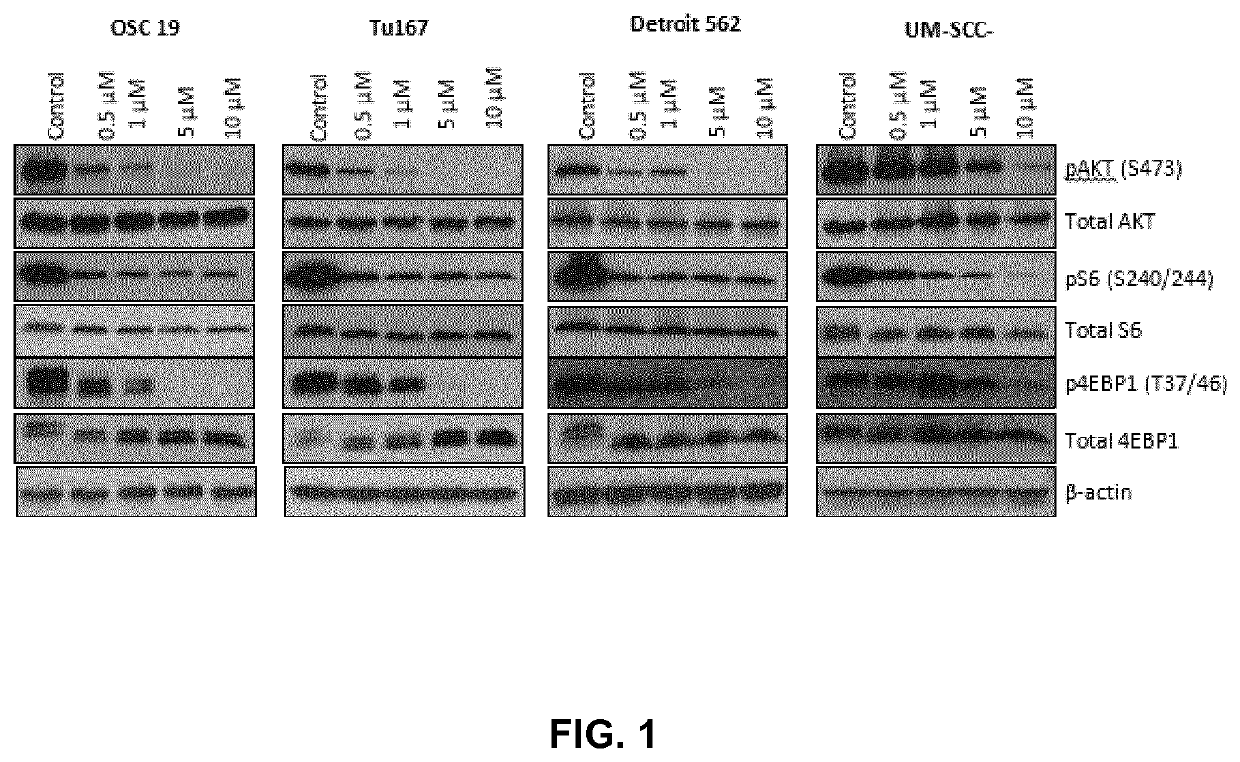Treatment of squamous cell carcinoma
a squamous cell carcinoma and squamous cell carcinoma technology, applied in the field of squamous cell carcinoma treatment, can solve the problems of rapid shrinkage and vulnerability of hns
- Summary
- Abstract
- Description
- Claims
- Application Information
AI Technical Summary
Benefits of technology
Problems solved by technology
Method used
Image
Examples
example 1
Testing of Efficacy of the Preferred Dual PI3K / mTOR Inhibitor Bimiralisib in a Panel of 69 HNSCC Cell Lines
[0307]We observed a decrease in pAKT, pS6 and p4EBP1 upon treatment with bimiralisib (FIG. 1). We tested 69 HNSCC cell lines for sensitivity to bimiralisib and found that the majority were sensitive and 66 cell lines had IC50 values 70 values <3 μM. To identify potential biomarkers of response to bimiralisib, we compared the drug sensitivity to baseline gene and protein expression as well as gene mutations. We found 3 proteins whose expression correlated with sensitivity to bimiralisib: CHK2, caveolin, and E2F1 while the sensitivity did not correlate with mutations in TP53, CDKN2A, CASP8, HRAS, PIK3CA), FAT1, AJUBA, FBXW7, KRAS, MAML. However, the sensitivity did best correlate with the presence of a NOTCH1 mutation (Table 1) indicating that there is sensitivity to bimiralisib in cells having NOTCH1 mutations.
[0308]IC50 values were estimated from the best-fit dose-response mode...
example 2
Exome Sequencing (WES) on 66 Established HNSCC Lines
[0309]To address the function of NOTCH1 mutations and other genes frequently altered in HNSCC, we performed whole exome sequencing (WES) on 66 established HNSCC lines. A number of these cell lines were mutant for NOTCH1 or had PIK3CA mutations in known hotspots, but they also had additional driver mutations frequently observed in HNSCC (FIG. 2) and were therefore reflective of genomic subtypes found in patients. Most NOTCH1 mutations in the HNSCC cell lines were truncating, and loss of NOTCH1 protein was confirmed in four of the mutant cell lines tested (FIG. 3A). A missense mutation (C478F) that occurred in two cell lines derived from the same patient (HN31 and HN30) was confirmed to result in loss of NOTCH1 signaling upon ligand activation (FIG. 3B). Using an antibody that recognized only the activated form of NOTCH1 (cl-NOTCH1), no signal was present in mutant UM47 (G192*) or HN31 (C478F) (FIG. 3B) when cells were cultured on im...
example 3
NOTCH1-LOF Mutants are More Sensitive than NOTCH1wt Cells to Drugs Targeting PI3K / mTOR
[0310]Six different HNSCC cell lines with and without NOTCH1 mutations were analyzed for their sensitivity towards bimiralisib. At 5 μM bimiralisib induces only cell death in HNSCC cell lines with NOTCH1 mutations as determined by BrDU-TUNEL staining, while in HNSCC NOTCH1wt bimiralisib arrested cell lines in G1 / S. Cell death as measured by BrdU-TUNEL was significantly increased in HNSCC cell lines with NOTCH1 mutations but not in HNSCC lines with NOTCH1wt or PIK3CA mutations (FIG. 4A). To further validate these findings an in vivo experiment was performed by sublingual implantation of 2 NOTCH1 mutant HNSCC cell lines (UM22A and HN31) and one NOTCH1wt HNSCC cell line (FaDu) (FIG. 4B) followed by once daily PO treatment with bimiralisib (50 mg / kg) for 28 days. This regiment of bimiralisib was well tolerated during the whole treatment period of 28 days without body weight loss. There was significant ...
PUM
| Property | Measurement | Unit |
|---|---|---|
| Fraction | aaaaa | aaaaa |
| Time | aaaaa | aaaaa |
| Time | aaaaa | aaaaa |
Abstract
Description
Claims
Application Information
 Login to View More
Login to View More - R&D
- Intellectual Property
- Life Sciences
- Materials
- Tech Scout
- Unparalleled Data Quality
- Higher Quality Content
- 60% Fewer Hallucinations
Browse by: Latest US Patents, China's latest patents, Technical Efficacy Thesaurus, Application Domain, Technology Topic, Popular Technical Reports.
© 2025 PatSnap. All rights reserved.Legal|Privacy policy|Modern Slavery Act Transparency Statement|Sitemap|About US| Contact US: help@patsnap.com



